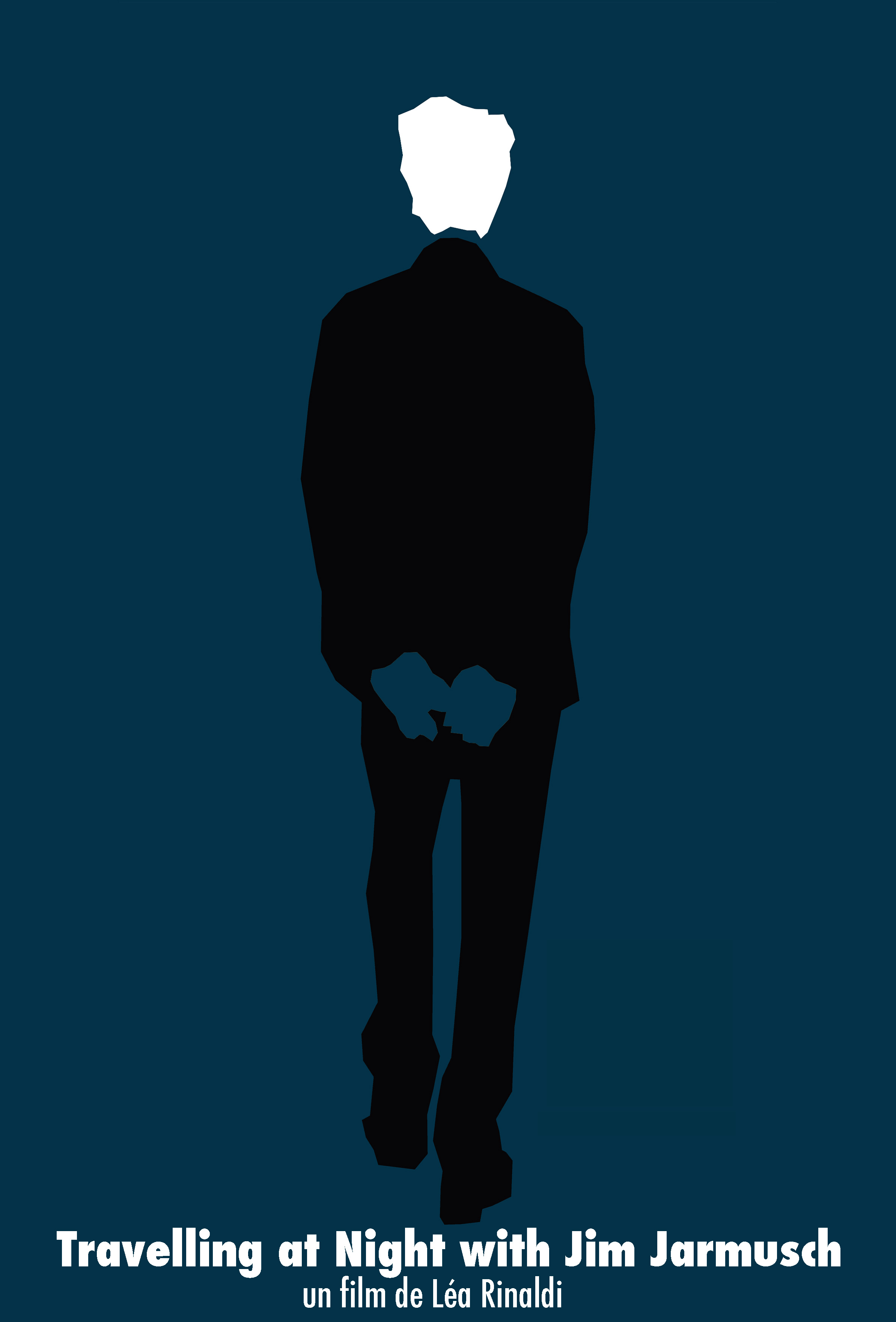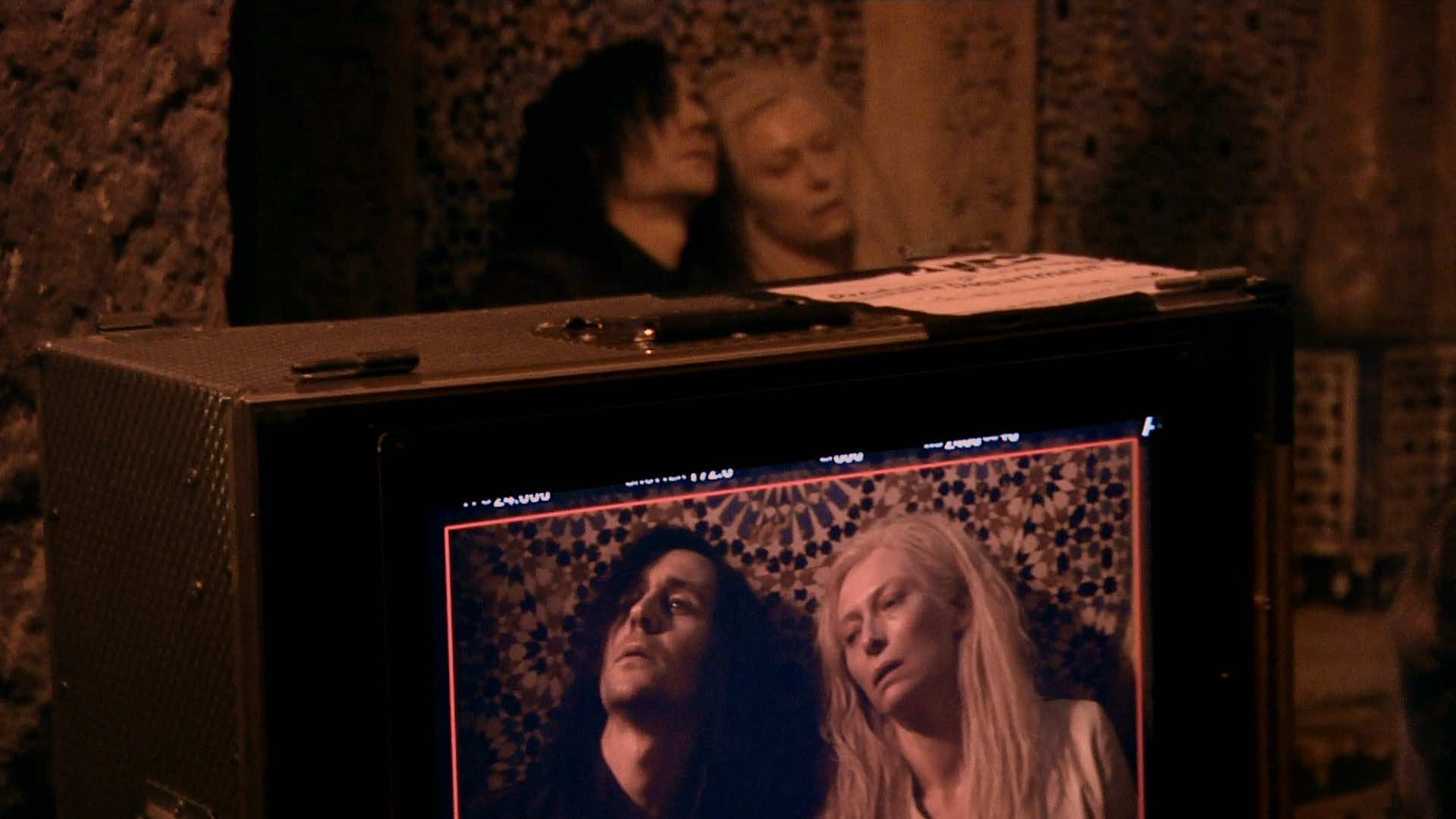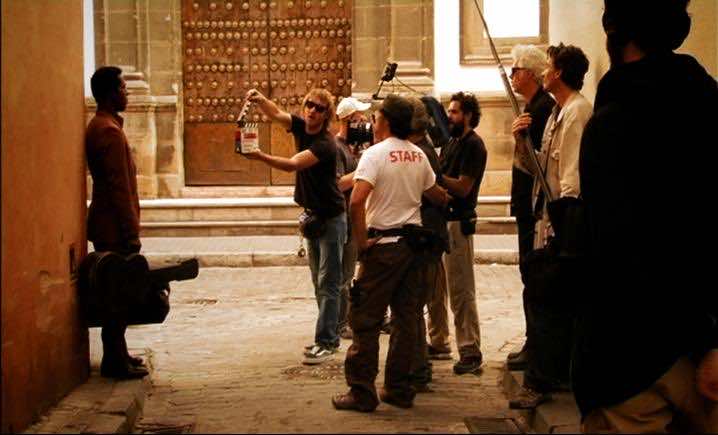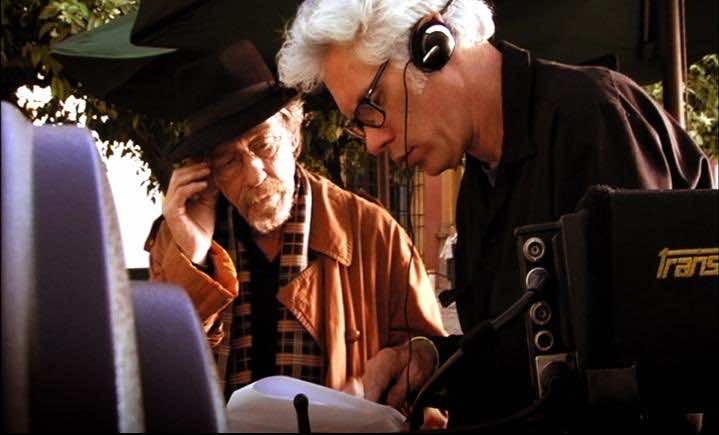 In all his years making movies, director Jim Jarmusch has never allowed anyone to shoot him at work. That is, until he met Léa Rinaldi, a French filmmaker who brought with her a distinctive eye for capturing the man in his process. Rinaldi’s first study of the indie film legend is available as an
In all his years making movies, director Jim Jarmusch has never allowed anyone to shoot him at work. That is, until he met Léa Rinaldi, a French filmmaker who brought with her a distinctive eye for capturing the man in his process. Rinaldi’s first study of the indie film legend is available as an
extra on the DVD of 2009’s The Limits of Control. Entitled “Behind Jim Jarmusch,” the film has a natural, fly-on-the-wall feel. From actors waiting on their cues, to fingernails pressing on a camera, Rinaldi focuses as much on the equipment on the set as she does the people. She truly gives the sense of the complex team effort needed to capture a few moments for the editing room. As Jarmusch says, while walking in the tight streets of Seville with Rinaldi, “You really make the film when you edit it.” There are many of these moments between scenes on set, as the director tosses casual insights over his shoulder to Rinaldi’s camera. She is never heard, however.
There has never been a so-called “behind-the-scenes” documentary as a supplement to any of Jarmusch’s movies prior to this, and he liked Rinaldi’s work enough to invite her back for his next movie. Her second and latest documentary on Jarmusch at work will have its American premiere at the Gasparilla Film Festival in Tampa today. “Travelling at Night with Jim Jarmusch,” captures the nocturnal shoot of Jarmusch’s brilliant vampire movie — and my favorite film of 2014 — Only Lovers Left Alive (Jim Jarmusch’s ‘Only Lovers Left Alive’ presents complex, enthralling portrait of the jaded vampire).
It was not easy for Rinaldi to get this access. The two struck up a friendship at Cannes, about eight years ago, she says. Speaking via Skype from Paris, the filmmaker recalls, “I met him in the Cannes Film Festival … I started like a local journalist for Canal+, and I was working for MK2, a distribution society, and I was making, every night, for Cannes a reportage about Cannes by night, and one night I met Jarmusch, and it was very fun because I said, ‘Hi, Jarmusch. How are you?’ and I gave my microphone to him, and I directed him. I told him to go to interview Isabelle Huppert, go to interview Iñárritu, and he was like ‘OK, OK!’ And it was a lot of fun and after he called MK2’s boss to get my number, and he called me and said, ‘Hey, Léa, I saw on television what you did, and it’s such a great video, and I like the way you use your camera.’”
They did not bond over making movies, however. “I never studied directing,” offers Rinaldi. “I studied literature, and so when we met next we talked a lot about poetry. Jarmusch loves poetry and loves French poetry and surrealist poetry, and so he talked to me on the phone. He called me two times to talk about poetry,” she adds with a laugh.
During this second telephone call, he mentioned he was shooting The Limits of Control in Spain. She says that’s when she took an opportunity to ask a bold question. Here’s how that conversation went, according to Rinaldi:
Rinaldi: “OK, you know, Jim, I’m a journalist of cinema, but I’ve never been on a shoot except my own short movie … OK, so you like my work, so can I propose you something? I would like to come to your movie not to make a making-of but a portrait of you working.”
Jarmusch: “Oh, I never let anyone film me while I’m shooting because I hate that. I’m shy. I don’t like to talk about my movie while I’m shooting. So, no.”
Rinaldi: “OK.”
Jarmusch: “What else would you like to do?”
Rinaldi: “OK, I’d like to be your assistant camera because I love to shoot.”
Jarmusch: “Ah, no. It’s not possible because I’m working with Christopher Doyle, and he’s a crazy guy, and it’s not possible. What else do you want to do?”
Rinaldi: “Me? I can make coffee.”
At the end of the conversation, she says Jarmusch told her, “‘OK, but you know, Léa, maybe I can change my mind,’ and he called me on the last day of the shooting, like nine months after, he called,” she pauses for a laugh, “and said, ‘OK, you want to come? Come in three days in Sevilla.”
His assistant then wrote to Rinaldi with details of her trip to Spain, and she asked for a script, as she had no idea what the film he was shooting was about. “But I never received the script,” notes Rinaldi. “I didn’t know the characters. I didn’t know nothing, and it was the greatest present for me. When you do a documentary it’s great to have a problematic character. It is great to adapt to a situation, and we follow the ambiance, and we start like this.”
As seen on the documentary, though Jarmusch shared thoughts on his film-making process, he preferred not to talk about the film itself and whatever the film was about remained a mystery to her (anyone who has seen the completed work might feel the same way). She says when she and Jarmusch spoke on set, they talked about trees, variations of nature, for example, but not the script or the story.
He loved her final work and invited her back to watch him shoot Only Lovers Left Alive. There was one major difference in this second documentary, however. He didn’t want to be seen addressing the camera at all. Says Rinaldi, “I think it was great. It’s hard to make a movie without interviews and without explanation, but I think it was the best contract. It was a challenge, but it was cool.”
“Travelling at Night with Jim Jarmusch” ends up being an even stronger work. She says she doesn’t like it when documentary filmmakers explain things for the audience. What you learn while watching this latest film by Rinaldi, for instance, is the collaborative relationship Jarmusch has with actress Tilda Swinton, who also appeared in The Limits of Control. “I think they are very close together,” notes Rinaldi, “and Tilda helped him a lot to make [Only Lovers], in the process of production. I think he was waiting like seven years, and she was encouraging, and now they’re friends. She’s not just an actress. She’s an artist, and she knows every job of the crew. For instance, when she starts the take, she knows that the sound man is here, and she says, ‘OK, it’s good for the sound.'”
Swinton comes across as a confidant collaborator in this documentary, offering suggestions to Jarmusch in how a scene should play out. You wonder if the director could possibly be compromising to the actress at times. “I asked him about it one night,” Rinaldi says. “I said, ‘But Tilda, she never directed a movie. He said, ‘Why are you asking that?’” and she laughs before continuing, “I said, ‘Because she’s like directing.’ He says, ‘Oh, no, no. She knows, but no, no.'” She pauses to laugh some more and adds about Swinton, “But she loves the process of directing.”
Another film festival isolated this scene that will give the viewer a sense of Swinton’s casual collaboration with Jarmusch:
https://vimeo.com/105425977
The wonderfully edited scene features, brief close-ups and keeps in mind people’s relationship with the film-making equipment. “I like the choreography and the poetry of the technical crew,” says Rinaldi. “The movie is the crew. I mean, Jarmusch is the director, but the movie is the crew. I like to shoot the choreography of the work because the movie cannot exist without the grip man, and it’s why I think Jarmusch likes my work.”
Her documentary is also very patient, allowing the viewer to watch a shoot unfold to note all the moving parts of the individual people involved, which she aptly calls “choreography.” As if to drive that point home, she ends the film in Tangiers with a beautiful long take of the crew, including the actors and director, marching single file after a long night’s shoot. If the clip above does not give you the sense of how Rinaldi gives equal time to the technology that brings the scenes to life, this clip should:
Asked what she thinks of the final results of Jarmusch’s work on Only Lovers, she says, “I love it. What I saw during the five-day shoot in Tangiers, I saw the sense of the film, so what I see in the film, it’s like I already saw it. Because this movie is very sincere and very personal and so close to Jim, so it wasn’t a surprise. It’s a beautiful gift. That’s what I like about cinema or documentaries. It’s not the technical stuff or the cast. It’s that people are honest and true with the topic. That’s what touches me in cinema, so I think, with this movie, Jarmusch is very sincere.”
She’s not just offering flattery about Jarmusch. Her friendship with him is not based on sycophancy. When reminded about the harsh critical response to The Limits of Control, she does not hold back. “Yeah, it’s very weak,” she says and laughs, “but it’s why I love Jarmusch because he doesn’t care. He does what he wants, and Jarmusch is weird, too. He was honest with his art to make a weird movie. He didn’t make a Jarmusch movie that people expect. If he wants to make something, he does it. If he wants to make a vampire movie, he does it. I asked him if I could make a documentary about him, even though I never directed something, he just trusted me, and he lets me do it. He’s a very, very free person, very open-minded, very generous, and I think very courageous to propose his own weird ideas. Even if it’s not popular or people won’t understand. It’s what I love about him. His work says it’s better to just express yourself and do what you want even if people don’t like it.”
“Travelling at Night with Jim Jarmusch” plays at Gasparilla Film Festival in Tampa, Florida, today, Thursday, March 26, at 9 p.m. Rinaldi will be present to introduce the film and entertain questions after the screening. For Tickets visit this link (that’s a hotlink, jump through). For those who cannot make the screening, the documentary is available as a special feature on the Only Lovers Left Alive blu-ray (Support the Independent Ethos, purchase direct through Amazon via this link).














